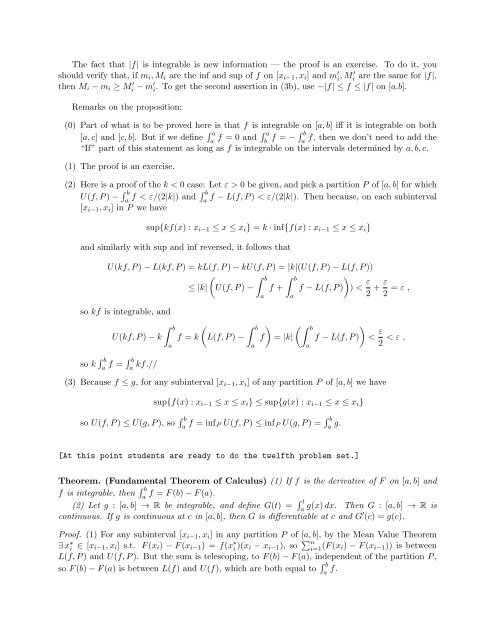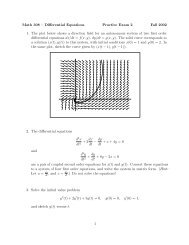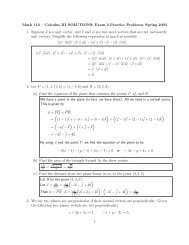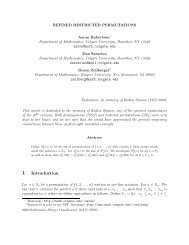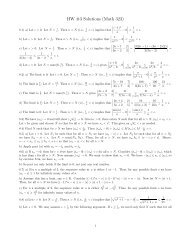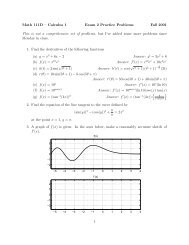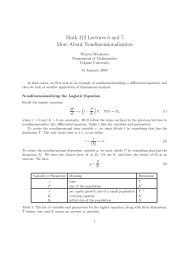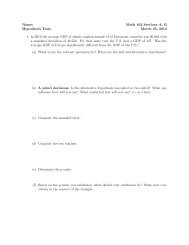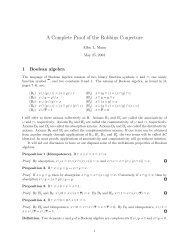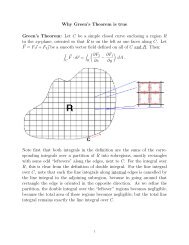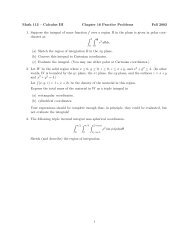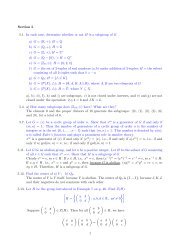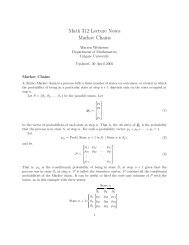Chapter 7: The Riemann Integral When the derivative is introduced ...
Chapter 7: The Riemann Integral When the derivative is introduced ...
Chapter 7: The Riemann Integral When the derivative is introduced ...
Create successful ePaper yourself
Turn your PDF publications into a flip-book with our unique Google optimized e-Paper software.
<strong>The</strong> fact that |f| <strong>is</strong> integrable <strong>is</strong> new information — <strong>the</strong> proof <strong>is</strong> an exerc<strong>is</strong>e. To do it, you<br />
should verify that, if m i , M i are <strong>the</strong> inf and sup of f on [x i−1 , x i ] and m ′ i , M i ′ are <strong>the</strong> same for |f|,<br />
<strong>the</strong>n M i − m i ≥ M i ′ − m′ i . To get <strong>the</strong> second assertion in (3b), use −|f| ≤ f ≤ |f| on [a.b].<br />
Remarks on <strong>the</strong> proposition:<br />
(0) Part of what <strong>is</strong> to be proved here <strong>is</strong> that f <strong>is</strong> integrable on [a, b] iff it <strong>is</strong> integrable on both<br />
[a, c] and [c, b]. But if we define ∫ a<br />
a f = 0 and ∫ a<br />
b f = − ∫ b<br />
a<br />
f, <strong>the</strong>n we don’t need to add <strong>the</strong><br />
“If” part of th<strong>is</strong> statement as long as f <strong>is</strong> integrable on <strong>the</strong> intervals determined by a, b, c.<br />
(1) <strong>The</strong> proof <strong>is</strong> an exerc<strong>is</strong>e.<br />
(2) Here <strong>is</strong> a proof of <strong>the</strong> k < 0 case: Let ε > 0 be given, and pick a partition P of [a, b] for which<br />
U(f, P ) − ∫ b<br />
a f < ε/(2|k|) and ∫ b<br />
a<br />
f − L(f, P ) < ε/(2|k|). <strong>The</strong>n because, on each subinterval<br />
[x i−1 , x i ] in P we have<br />
sup{kf(x) : x i−1 ≤ x ≤ x i } = k · inf{f(x) : x i−1 ≤ x ≤ x i }<br />
and similarly with sup and inf reversed, it follows that<br />
U(kf, P ) − L(kf, P ) = kL(f, P ) − kU(f, P ) = |k|(U(f, P ) − L(f, P ))<br />
( ∫ b ∫ b<br />
)<br />
≤ |k| U(f, P ) − f + f − L(f, P ) ) < ε 2 + ε 2 = ε ,<br />
so kf <strong>is</strong> integrable, and<br />
U(kf, P ) − k<br />
so k ∫ b<br />
a f = ∫ b<br />
a kf.//<br />
∫ b<br />
a<br />
(<br />
f = k L(f, P ) −<br />
∫ b<br />
a<br />
a<br />
a<br />
) (∫ b<br />
)<br />
f = |k| f − L(f, P ) < ε<br />
a<br />
2 < ε ,<br />
(3) Because f ≤ g, for any subinterval [x i−1 , x i ] of any partition P of [a, b] we have<br />
sup{f(x) : x i−1 ≤ x ≤ x i } ≤ sup{g(x) : x i−1 ≤ x ≤ x i }<br />
so U(f, P ) ≤ U(g, P ), so ∫ b<br />
a f = inf P U(f, P ) ≤ inf P U(g, P ) = ∫ b<br />
a g.<br />
[At th<strong>is</strong> point students are ready to do <strong>the</strong> twelfth problem set.]<br />
<strong>The</strong>orem. (Fundamental <strong>The</strong>orem of Calculus) (1) If f <strong>is</strong> <strong>the</strong> <strong>derivative</strong> of F on [a, b] and<br />
f <strong>is</strong> integrable, <strong>the</strong>n ∫ b<br />
a<br />
f = F (b) − F (a).<br />
(2) Let g : [a, b] → R be integrable, and define G(t) = ∫ t<br />
a<br />
g(x) dx. <strong>The</strong>n G : [a, b] → R <strong>is</strong><br />
continuous. If g <strong>is</strong> continuous at c in [a, b], <strong>the</strong>n G <strong>is</strong> differentiable at c and G ′ (c) = g(c).<br />
Proof. (1) For any subinterval [x i−1 , x i ] in any partition P of [a, b], by <strong>the</strong> Mean Value <strong>The</strong>orem<br />
∃ x ∗ i ∈ [x i−1 , x i ] s.t. F (x i ) − F (x i−1 ) = f(x ∗ i )(x i − x i−1 ), so ∑ n<br />
i=1 (F (x i) − F (x i−1 )) <strong>is</strong> between<br />
L(f, P ) and U(f, P ). But <strong>the</strong> sum <strong>is</strong> telescoping, to F (b) − F (a), independent of <strong>the</strong> partition P ,<br />
so F (b) − F (a) <strong>is</strong> between L(f) and U(f), which are both equal to ∫ b<br />
a f.


